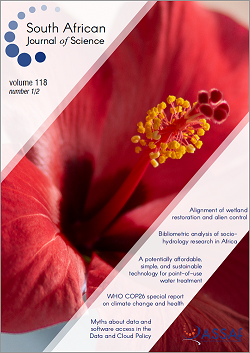The alignment of projects dealing with wetland restoration and alien control: A challenge for conservation management in South Africa (with corrigendum)
DOI:
https://doi.org/10.17159/sajs.2022/11540Keywords:
invasive species, Expanded Public Works Programme, ecological restoration, revegetation, wetland plantsAbstract
An inventory of wetland vegetation across the country generated a list of the most common invasive alien plants across South Africa. Many of the plants on that list do not correspond with the priorities in the programmes for alien control across the country, as they are not listed on a government produced list that guides the priorities for alien control. We explore the reasons for this situation. We argue that because wetlands are such important parts of the landscape, invasive aliens in wetlands are of special concern, and there should be more alignment between alien control programmes and wetland rehabilitation programmes. This alignment starts by considering the full number of species that form a threat to wetland habitats, but also considers which pesticides to use, erosion and recolonisation in wetlands, planting indigenous vegetation after aliens have been removed, and strategising by working from upstream to downstream. Existing alien control programmes for specific grasses (some relatively new to the country and in the phase of early detection) and floating aquatic plants may guide how to tackle the invasions of grasses and forbs that have been established in South African wetlands for an extended period of time.
Significance:
- Wetlands have a distinct set of alien invasive plants that affect their ecology and functioning and many of these plants are not listed as priorities in alien control programmes.
- Many restoration projects have an element of removing invasive plants and revegetating. Wetland restoration and alien control need to be integrated to preserve water resources.
Additional Files
Published
Issue
Section
License

All articles are published under a Creative Commons Attribution 4.0 International Licence
Copyright is retained by the authors. Readers are welcome to reproduce, share and adapt the content without permission provided the source is attributed.
Disclaimer: The publisher and editors accept no responsibility for statements made by the authors
How to Cite
- Abstract 1090
- Corrigendum 166
- PDF 1077
- EPUB 499
- XML 647
Funding data
-
Water Research Commission
Grant numbers K5/1980












.png)